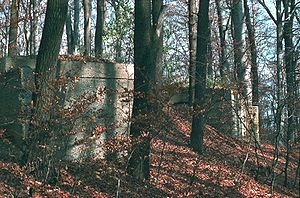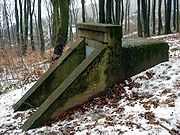
Gaugefechtsstand Wien
Encyclopedia

World War II
World War II, or the Second World War , was a global conflict lasting from 1939 to 1945, involving most of the world's nations—including all of the great powers—eventually forming two opposing military alliances: the Allies and the Axis...
subterranean command bunker
Bunker
A military bunker is a hardened shelter, often buried partly or fully underground, designed to protect the inhabitants from falling bombs or other attacks...
situated in the densely forested Wienerwald
Wienerwald
The Vienna Woods are forested highlands that form the northeastern foothills of the Northern Limestone Alps in the states of Lower Austria and Vienna. The long and wide hill range is heavily wooded and a popular recreation area with the Viennese....
western parts of Ottakring
Ottakring
Ottakring is the 16th District in the city of Vienna, Austria . It is located west of the central districts, north of Penzing and south of Hernals. Ottakring has some heavily populated urban areas with many residential buildings...
, the 16th district of Vienna
Vienna
Vienna is the capital and largest city of the Republic of Austria and one of the nine states of Austria. Vienna is Austria's primary city, with a population of about 1.723 million , and is by far the largest city in Austria, as well as its cultural, economic, and political centre...
. Commonly known as the Schirach-Bunker (named after the Nazi governor for the Reichsgau
Reichsgau
A Reichsgau was an administrative subdivision created in a number of the areas annexed to Nazi Germany between 1938 and 1945...
Wien, Baldur von Schirach
Baldur von Schirach
Baldur Benedikt von Schirach was a Nazi youth leader later convicted of being a war criminal. Schirach was the head of the Hitler-Jugend and Gauleiter and Reichsstatthalter of Vienna....
), the facilities were constructed between 1942 and 1945 as a massive underground extension to barracks that had been established in 1940.
Function and layout
The primary function of the Gaugefechtsstand Wien was to provide strategic air raidStrategic bombing
Strategic bombing is a military strategy used in a total war with the goal of defeating an enemy nation-state by destroying its economic ability and public will to wage war rather than destroying its land or naval forces...
warning and air defence coordination for Vienna (which was defended by three Flak tower
Flak tower
Flak towers were 8 complexes of large, above-ground, anti-aircraft gun blockhouse towers constructed in the cities of Berlin , Hamburg , and Vienna from 1940 onwards....
s) and to assist air defence in the entire south-eastern region of the Third Reich. The Drahtfunk (a power line communication
Power line communication
Power line communication or power line carrier , also known as power line digital subscriber line , mains communication, power line telecom , power line networking , or broadband over power lines are systems for carrying data on a conductor also used for electric power transmission.A wide range...
system similar to the to Norwegian Linjesender
Linjesender
A Linjesender was a low power longwave transmitter used for broadcasting in Norway. It consisted of a power line communication system, which fed the radio programme on a frequency in the longwave broadcasting range into an overhead electric power transmission line.Because Norway has many mountains,...
) was used to broadcast air raid warnings.
From the main entrance at the top of the Gallitzinberg
Gallitzinberg
The Gallitzinberg is a forested hill in the West of Austria's capital, Vienna. While it is relatively unconspicous in the broader context of the Northeastern end of the Wienerwald mountain range, it is nevertheless remarkable because of its multifaceted history, and because it functions as an...
hill, a blast-proofed staircase descended 25 meters to the main tunnel (profile, 2 x 2 meters) which ran for about 100 meters horizontally to the north, ending in a secondary entrance where a small power plant was situated. Another tunnel diverged eastward towards the 17 x 5 meter actual bunker core. On its upper level were the communications facilities, with landlines to all civil emergency services, the Führer Headquarters
Führer Headquarters
The Führer Headquarters , abbreviated FHQ, is a common name for a number of official headquarters used by the Nazi leader Adolf Hitler and various German commanders and officials throughout Europe during World War II...
, the Oberkommando der Luftwaffe
Oberkommando der Luftwaffe
The Oberkommando der Luftwaffe was the air force High Command of the Third Reich.Air Force Commanders-in-Chief* Reich Marshal Hermann Göring * Field Marshal Robert Ritter von Greim -History:...
and even the Kriegsmarine
Kriegsmarine
The Kriegsmarine was the name of the German Navy during the Nazi regime . It superseded the Kaiserliche Marine of World War I and the post-war Reichsmarine. The Kriegsmarine was one of three official branches of the Wehrmacht, the unified armed forces of Nazi Germany.The Kriegsmarine grew rapidly...
. On the lower level were the command center, a meeting room and Schirach's personal facilities. The tunnel system had a total length of 340 meters. A tripartite security zone system controlled access to the installation.
The Gaugefechtsstand Wien was evacuated, and its entrances were destroyed by explosives, on April 4, 1945 as the advancing Red Army
Red Army
The Workers' and Peasants' Red Army started out as the Soviet Union's revolutionary communist combat groups during the Russian Civil War of 1918-1922. It grew into the national army of the Soviet Union. By the 1930s the Red Army was among the largest armies in history.The "Red Army" name refers to...
shock troops took Hütteldorf
Hütteldorf
Hütteldorf is a part of Vienna's 14th district, Penzing. It is located in the west of Vienna, but roughly in the geographical center of the district, stretching roughly from Deutschordenstraße in the east to Wolf in der Au in the west, where Hütteldorf borders Hadersdorf-Weidlingau.Hütteldorf is...
, a suburb of Vienna situated 2.5 km southward of the command center.
Post-war period

In 2003 an Austrian government commission briefly opened and entered parts of the former Gaugefechtsstand, avoiding publicity and without directly reporting results of the investigations. Subsequently a Viennese journalist published a book which included sketches and statements by two women who had served at the communications center during the war. His suggestion to excavate the bunker was dismissed. In 2007 the historical communications journal of the city of Vienna published a review article on the construction of the bunker.
External links
- Report of private exploration attempt (German) with photos Archived
- 3D Photosynth assembly of a drainage access (requires Microsoft Live Labs Photosynth plugin or Microsoft SilverlightMicrosoft SilverlightMicrosoft Silverlight is an application framework for writing and running rich Internet applications, with features and purposes similar to those of Adobe Flash. The run-time environment for Silverlight is available as a plug-in for web browsers running under Microsoft Windows and Mac OS X...
)

